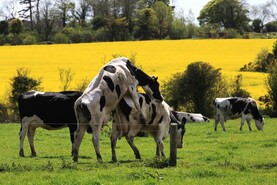Flock prolificacy and the stocking rate at which ewes are run are the two main factors influencing potential profitability in sheep systems. Increasing prolificacy is an easier route to achieving progress faster for many flocks as the number of ewes does not need to change to increase lamb output.
Teagasc's Tim Keady said: “Increasing the number of lambs reared per ewe joined is the main factor influencing the profitability of grass-based systems of prime lamb production”.
Despite research showing the potential that exists to lift farm output and performance, many farmers remain reluctant to utilise high-prolificacy genetics.
Higher numbers
The reasoning is generally a fear of having to deal with a higher number of triplet- or quad-bearing ewes, which is inevitable in high-prolificacy flocks.
For example, for flocks with mean litter sizes of 1.8, 2.0 and 2.2 lambs, the incidence of triplets is expected to be 8%, 15% and 25% respectively.
Tim said: “Consequently, an issue that faces producers with prolific flocks is what to do with triplets. In some flocks, triplets are reared by their dams and managed as a separate flock.
"Other producers remove one lamb from each set of triplets and this lamb is either cross-fostered to single-bearing ewes, sold for cross-fostering or artificially reared.”
Survey
A survey is currently being undertaken to gauge farmer attitudes to triplets, along with exploring management practices in late pregnancy and from lambing through to weaning.
It is being conducted in collaboration with four institutes: Dr Tim Keady from Teagasc; Professor Cathy Dwyer and Catherine Erichsen, SRUC and University of Edinburgh; and Dr Sue McCoard of AgResearch in New Zealand.
The survey is completely anonymous can be completed online here. The survey takes approximately 15 minutes to complete.
Read more
Assessing the best method of rearing surplus lambs
Flock prolificacy and the stocking rate at which ewes are run are the two main factors influencing potential profitability in sheep systems. Increasing prolificacy is an easier route to achieving progress faster for many flocks as the number of ewes does not need to change to increase lamb output.
Teagasc's Tim Keady said: “Increasing the number of lambs reared per ewe joined is the main factor influencing the profitability of grass-based systems of prime lamb production”.
Despite research showing the potential that exists to lift farm output and performance, many farmers remain reluctant to utilise high-prolificacy genetics.
Higher numbers
The reasoning is generally a fear of having to deal with a higher number of triplet- or quad-bearing ewes, which is inevitable in high-prolificacy flocks.
For example, for flocks with mean litter sizes of 1.8, 2.0 and 2.2 lambs, the incidence of triplets is expected to be 8%, 15% and 25% respectively.
Tim said: “Consequently, an issue that faces producers with prolific flocks is what to do with triplets. In some flocks, triplets are reared by their dams and managed as a separate flock.
"Other producers remove one lamb from each set of triplets and this lamb is either cross-fostered to single-bearing ewes, sold for cross-fostering or artificially reared.”
Survey
A survey is currently being undertaken to gauge farmer attitudes to triplets, along with exploring management practices in late pregnancy and from lambing through to weaning.
It is being conducted in collaboration with four institutes: Dr Tim Keady from Teagasc; Professor Cathy Dwyer and Catherine Erichsen, SRUC and University of Edinburgh; and Dr Sue McCoard of AgResearch in New Zealand.
The survey is completely anonymous can be completed online here. The survey takes approximately 15 minutes to complete.
Read more
Assessing the best method of rearing surplus lambs






 This is a subscriber-only article
This is a subscriber-only article











SHARING OPTIONS: